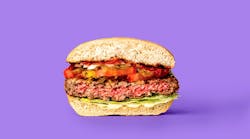This article is part of a series on Disruptors to Watch in the Food Industry. You can read the full series, starting here
The name of Impossible Foods works on so many levels.
It’s impossible for a plant-based burger to taste so much like the real thing. The company has had an impossible degree of success, establishing itself in more than 8,000 restaurants, including major hamburger chains like Burger King. And the ultimate dream of its founder, Stanford biochemist Pat Brown, seems utterly impossible: Replacing animals entirely as a source of meat.
The Impossible Burger’s current version 2.0 was introduced last January. By April, it was going through a tryout at a few St. Louis Burger Kings, which was so successful that Burger King promptly committed to rolling it out at all of its more than 7,000 U.S. locations by the end of this year.
Burger King is the latest and most significant conquest of the Impossible Burger; other foodservice partners include White Castle and Red Robin. Impossible Burgers will also be available at retail by the end of this year.
That’s why Impossible Foods is racing to increase capacity, an effort that includes adding a third shift, soliciting volunteers from R&D to work in production, and ultimately adding a second production line. Its facility, in Oakland, Calif., runs two 12-hour shifts per day and recently hired 25 more workers, bringing its full-time staff to 130. The company literally cannot produce enough to meet demand.
Legume hemoglobin, or “heme,” is the difference between the Impossible Burger and other analogue meat products.
“We underestimated the surge in demand that we would see, and it caught us off-guard. That’s not a good thing, but I think it also has a positive effect of really giving us a heads-up that we need to build a supply chain that’s big enough and flexible enough that next time this happens, we can respond immediately,” Brown says.
From Brown’s point of view, Impossible Foods has an insuperable advantage over Beyond Meat and any of the other companies, including some deep-pocketed giants, that are crowding into the plant-based analogue meat category: The best available technology. Impossible’s scientists developed a process to make legume hemoglobin, or “heme,” normally found in soy plants, from bioengineered yeast. This is the key ingredient in a formulation that enables the Impossible Burger to look, taste and even “bleed” like the real thing. It’s a proprietary, patented ingredient that no one else has access to.
“You cannot create the flavor and aroma and culinary properties of meat without heme,” Brown says. “It’s categorically unique as a catalyst. It is the reason that we taste like meat.”
Tasting like actual, animal-based meat is the core of Impossible Foods’ strategy. Brown is not interested in competing with other companies for the meat analogue market, which is growing but is still a fraction of 1 percent of the overall meat market. He’s going after the real thing. That’s why Impossible Foods, which Brown founded in 2011, spent years as an R&D company before it started releasing product.
“We were not going to release a product until it was good enough to be on the menus of top-flight, meat-focused restaurants,” he says. “Otherwise, it’s just not going to win over meat-loving consumers, which are the only consumers we care about.”
Getting on the menu at places like Burger King is a great start, but to Brown, it’s only a start. Plans include replicas of whole-muscle cuts like steaks, which he says is technologically within reach and is just a question of scaling up to achieve the necessary volume. In fact, low volume is the only reason Impossible’s products are now more expensive than regular meat.
Once that’s overcome, he says, the meat world had better watch out, because Impossible products require just fractions of the land area, fertilizer and other inputs required by animal-based meat: “The economics, structurally, are vastly in our favor.”


